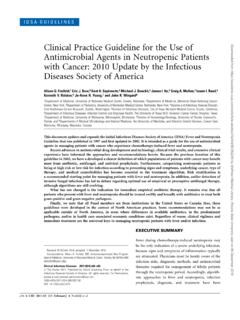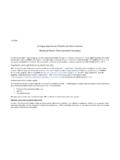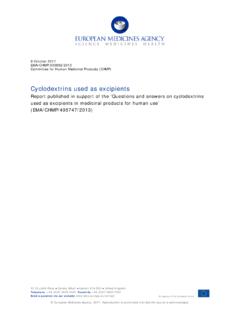Transcription of EXPOSURE TO ARSENIC: A MAJOR PUBLIC HEALTH CONCERN
1 PREVENTING DISEASE THROUGH HEALTHY ENVIRONMENTS EXPOSURE TO ARSENIC: A MAJOR PUBLIC HEALTH CONCERN Soluble inorganic arsenic is acutely toxic. Intake of inorganic arsenic over a long period can lead to chronic arsenic poisoning (arsenicosis). Effects, which can take years to develop depending on the level of EXPOSURE , include skin lesions, peripheral neuropathy, gastrointestinal symptoms, diabetes, renal system effects, cardiovascular disease and cancer. Organic arsenic compounds, which are abundant in seafood, are less harmful to HEALTH and are rapidly eliminated by the Human EXPOSURE to elevated levels of inorganic arsenic occurs mainly through the consumption of groundwater containing naturally high levels of inorganic arsenic, food prepared with this water and food crops irrigated with high-arsenic water sources.
2 PUBLIC HEALTH actions are needed to reduce human EXPOSURE to arsenic, particularly in areas with naturally high levels in groundwater. Sources of EXPOSURE to arsenic Arsenic is widely distributed throughout Earth s crust, generally as arsenic sulfide or as metal arsenates and arsenides. It can be released to the atmosphere, primarily as the trioxide, mainly by high-temperature processes. In the atmosphere, it is mainly adsorbed on particles, which are dispersed by winds and deposited on land and water. Arsenic can be released into the atmosphere and water in the following ways: natural activities, such as volcanic activity, dissolution of minerals (particularly into groundwater), exudates from vegetation and wind-blown dusts; human activities, such as mining, metal smelting, combustion of fossil fuels, agricultural pesticide production and use, and timber treatment with preservatives; remobilization of historic sources, such as mine drainage water; mobilization into drinking-water from geological deposits by drilling of tube wells.
3 Drinking-water Drinking-water poses the greatest threat to PUBLIC HEALTH from arsenic. Inorganic arsenic is naturally present at high levels in the groundwater of a number of countries, such as Argentina, Chile, China, India (West Bengal), Mexico, the United States of America, and particularly Bangladesh where approximately half of the total population is at risk of drinking arsenic-contaminated water from tube wells. In one estimate, consumption of arsenic-contaminated drinking-water in Bangladesh resulted in about 9100 deaths and 125 000 disability-adjusted life years (DALYs*) in * The DALY combines the burden due to death and disability in a single index. Use of such an index permits the comparison of the burden due to various environmental risk factors with those from other risk factors or diseases.
4 One DALY can be thought of as 1 lost year of healthy life. Industrial processes Most arsenic in industrial processes is used to produce antifungal wood preservatives, which can lead to soil contamination. It is also used in the pharmaceutical and glass industries, in the manufacture of alloys, sheep dips, leather preservatives, arsenic-containing pigments, antifouling paints and poison baits and, to a diminishing extent, in the production of agrochemicals (especially for use in orchards and vineyards). Arsenic compounds are also employed in limited amounts in the microelectronics and optical industries. High arsenic levels in air can be found in the working environment as well as the general environment around non-ferrous metal smelters, where arsenic trioxide may be formed, and some coal-fired power plants (especially those using low-grade brown coal).
5 3 Food In areas where arsenic is not naturally present at high levels, food usually contributes most to the daily intake of arsenic. Fish, shellfish, meat, poultry, dairy products and cereals are the main sources of dietary intake. However, the arsenic content of fish and shellfish usually involves organic compounds ( arsenobetaine) that are of low In areas where arsenic is naturally present at high levels, food ( rice) prepared with high-arsenic water and food crops irrigated with contaminated water also contribute to total daily intake. Smoking EXPOSURE of smokers to arsenic arises from the natural inorganic arsenic content of tobacco. This content is increased where tobacco plants have been treated with lead arsenate insecticide.
6 Smelter workers, who have an elevated risk of developing lung cancer due to arsenic EXPOSURE , further increase their risk by ,5 World HEALTH Organization (WHO) arsenic guidelines Tolerable intake level In a review of the latest scientific evidence conducted in 2010, the Joint Food and Agriculture Organization of the United Nations (FAO)/WHO Expert Committee on Food Additives (JECFA) determined the lower limit on the benchmark dose for a increased incidence of lung cancer ( ) from epidemiological data to be g/kg body weight per day (2 7 g/kg body weight per day based on the range of estimated total dietary EXPOSURE ). The Committee noted that the previously established provisional tolerable weekly intake (PTWI) of 15 g/kg body weight (equivalent to g/kg body weight per day) for inorganic arsenic was in the region of the and therefore was no longer appropriate.
7 This PTWI was therefore withdrawn by the No new tolerable intake level could be established. In areas where levels in water are below the WHO drinking-water guideline value, human HEALTH effects are unlikely. Drinking-water 10 g/l (provisional guideline value, in view of scientific uncertainties surrounding the risk assessment for arsenic carcinogenicity)7 Air A safe level of arsenic in air cannot be HEALTH effects8,9 Ill effects associated with elevated exposures to inorganic arsenic via the oral route are most likely to occur through consumption of arsenic-contaminated drinking-water. In contrast, EXPOSURE to inorganic arsenic from the diet is generally much lower. The intake of small quantities of organic arsenic via seafood does not pose a HEALTH risk.
8 Acute effects The immediate symptoms of acute arsenic poisoning include vomiting, abdominal pain and diarrhoea. These are followed by numbness and tingling of the extremities, muscle cramping and death, in extreme cases. Effects of long-term EXPOSURE During long-term EXPOSURE to high levels of inorganic arsenic ( through drinking-water), the first changes are usually seen in the skin: pigmentation changes and then skin lesions and hard patches on the palms of the hands and soles of the feet. Other effects of long-term EXPOSURE to high inorganic arsenic levels include peripheral neuropathy, gastrointestinal symptoms, conjunctivitis, diabetes, renal system effects, enlarged liver, bone marrow depression, destruction of erythrocytes, high blood pressure and cardiovascular disease.
9 The latter has been found in Taiwan, China, to include blackfoot disease, a severe disease of blood vessels leading to gangrene. Malnutrition may contribute to its development. Inorganic arsenic is one of the few substances that have been shown to cause cancer in humans through consumption of drinking-water. Cancer usually takes more than 10 years to develop. Arsenic can cause cancers of the skin, bladder and lungs, and there is limited evidence that it may also cause cancers of the kidney, liver and The International Agency for Research on Cancer (IARC) has classified arsenic and arsenic compounds as carcinogenic to humans (Group 1), which means that there is sufficient evidence for their carcinogenicity in The organic arsenic compounds monomethylarsonic acid and dimethylarsinic acid are the active ingredients of some herbicides and are metabolites of inorganic arsenic.
10 On the basis of sufficient evidence of cancer in experimental animals and because monomethylarsonic acid is extensively metabolized to dimethylarsinic acid, both compounds are classified as possibly carcinogenic to humans (Group 2B). Arsenobetaine and other organic compounds that are not metabolized in humans are not classifiable as to their carcinogenicity (Group 3).10 Furthermore, IARC has stated that arsenic in drinking-water is carcinogenic to humans (Group 1).11 Arsenic can pass through the placenta. Pregnant women chronically exposed to arsenic-contaminated drinking-water are at increased risk for spontaneous abortion, stillbirth and preterm birth. In utero and early-life exposures to arsenic have been linked to the development of lung cancer and bronchiectasia later in life.














